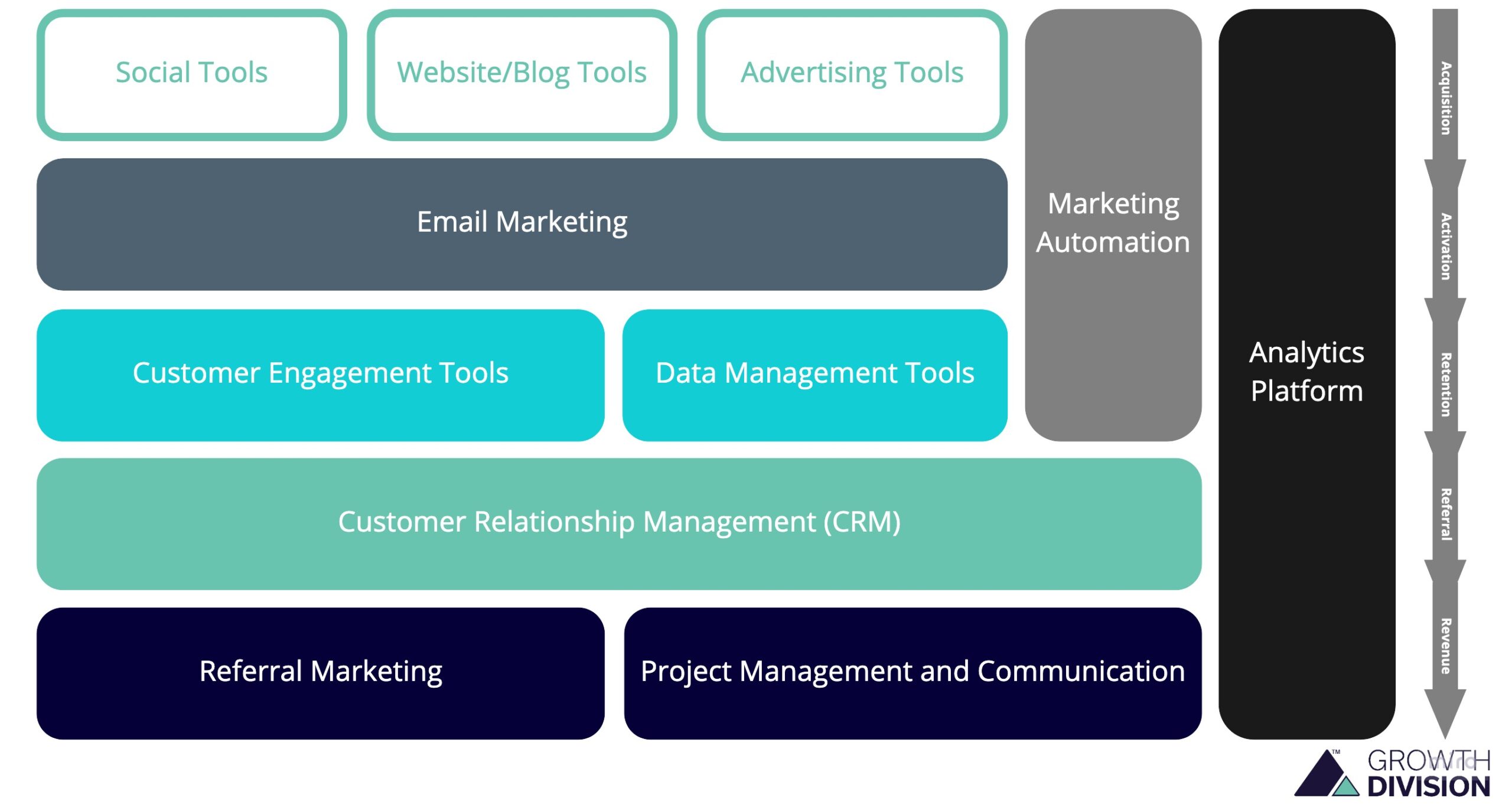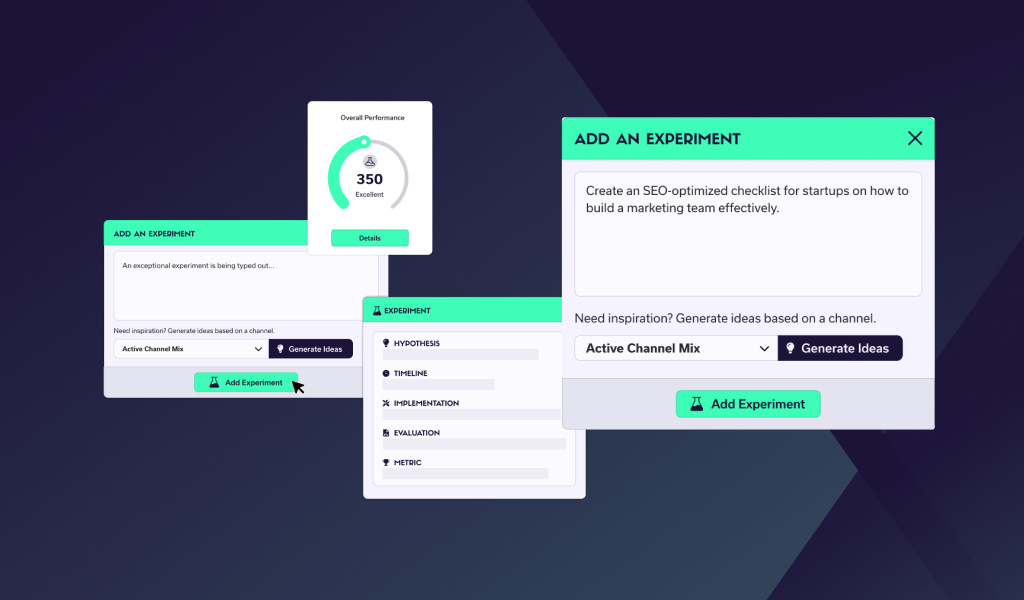What is a Martech Stack?
A martech (marketing technology stack) stack is a suite of integrated marketing technology tools that propel your business and marketing efforts to new heights. The focus is to improve marketing operations, analyse growth experiments and to generate customers using exciting new methodologies, marketing tools, and marketing strategies that would be impossible or impractical without a proper marketing technology stack . So, let's explore what makes up a marketing stack.
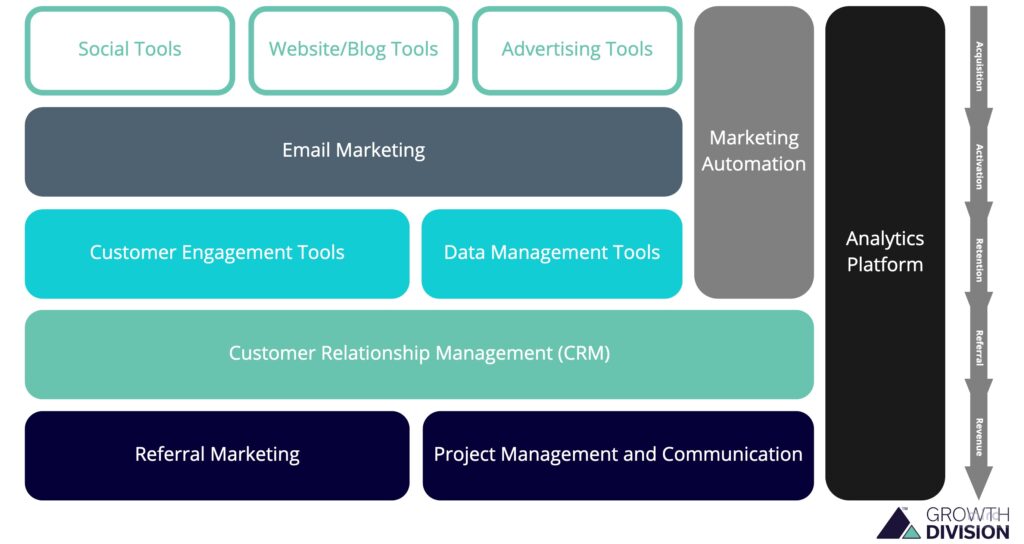
Start stacking up your marketing tools in these areas
Martech Stack Definition
A marketing technology stack is a suite of integrated marketing technology tools that create business growth. The term ‘stack' has been used in technology for years as developers describe their various technologies and codebases this way. You've probably come across a ‘full-stack' developer at some stage.
As the number of marketing tech tools available to marketers has increased over the same number of years, a ‘stack' is now more commonly used. Much like a product tech stack, a marketing stack is well integrated and operates as a cohesive unit.
Historically, marketers have used various marketing tools in silos and in isolation from one another. This causes problems. From data duplication to wasted time and effort, we've seen it happen! The characteristics of the forward-thinking marketing department is their strategic use of tools in a streamlined way. Growth Division as a leading growth marketing agency has always understood the importance of using the right tools, tried and tested.
When done correctly, a martech stack will improve sales and marketing operations and automate various processes. Embed an integrated web analytics platform and your commercial operations will be set for atmospheric growth.
Marketing Technology Landscape
The number of martech tools available has moved in lockstep with the popularity of the term itself. Over the last 8 years, the number of marketing tools has grown 4500% according to the research from Chief Martec (image below). The scope of various sectors has creeped, as represented by the 6 categories and 50 subcategories in the 2019 analysis. As such, navigating the marketing technology landscape is becoming an increasingly challenging task marketing teams.

MarTech is growing exponentially - can you keep up?
Martech is growing exponentially - can you keep up?
As the number of digital marketing tools increases, the old-school data silo habits are creeping back in. Tools are becoming increasingly integrated, but implementing and hacking around these integrations can be a challenge for digital marketing teams. It's no surprise then that ‘data solutions' was the area of highest growth coming into 2020 at 25.5% year-on-year (MarTech Today). Knocking down these data silos is the new challenge for marketing leaders.
Down with silos. Long live dashboards!
Ensuring that marketing data is cleanly and clearly flowing between systems like your content management system, your CRM, your accounting software, your email marketing tool, your social media management platform, your web analytics / google analytics, and any other marketing automation tools is paramount in driving successful marketing processes. If any of these are operating in a vacuum, your marketing tech stack will not be running optimally.
If the categories and subcategories are increasing, how are marketing leaders and sales professional to know which tools to use for their business?
Whilst there are some baseline marketing technologies that any digital business should use these days, building your stack simply by adding a tool for each category won't be effective (eg CRM, email marketing, social media, content marketing, search engine marketing, or a content management system). You need to have a marketing strategies focused on growth, and then build your stack to implement and execute on the marketing processes.
Benefits of a Martech Stack
More efficient marketing operations
Do more with less. This is what a good martech stack enables a company to achieve. A well oiled marketing machine can generate customers in a sustainable way with little or no effort.
You just need to ensure you set the martech stack up correctly and run effective campaigns to support the sales engagement / marketing teams.
Marketing Automation for the win.
Get your tools to do the heavy lifting for you and then make sure they're integrated to avoid wasting time on administrative tasks.
Ensure visibility and communication
If your stack requires some manual data migrations, then you can usually employ a virtual assistant to manage this for you or your team. Don't forget to ensure the tools integrate with your favourite communications platform (Slack?). This smooths over any communication issues and ensures everyone's on the same page.
Outsource wherever you can.
We've come across rapidly growing businesses who effectively outsource their marketing activities to experts (we work with a few). Gone are the days when you needed to hire a marketing team that specialises in every channel you want to test.
Expertise is critical
Due to the high degree of specialisation across the many disciplines of marketing, from email marketing to keyword research, SEO tools to content marketing, social media campaigns to website analytics, google ads and the sheer variety of marketing channels makes it impossible to master them all. It makes the case easy for hiring outside specialists and easy one.
Experiment like your business depends on it (it does!)
Get the tooling in place, run experiments and then double down on the ones that work. If you find yourself in a position where there is full time or more work in a specific channel - then consider building or adding to the in-house marketing team. Outsourcing is also a great check and balance against under performing marketing channels - a second set of eyes can make all the difference in campaign performance.
Remove data silos and duplication
The core benefit of an integrated martech stack is the smooth flow of data between systems. Data shouldn't be a burdensome worry to your team and should be used to improve customer engagement and internal optimisations. You can blow your customer's mind by communicating with them in a personalised way at the correct point in their customer journey.
Customer Data Platforms
When you're building your martech stacks, you need to consider where data is collected, where it is being kept and what triggers its movement between tools. If you've got a lot of data being passed between your product tech stack and your martech stacks, then we would recommend implementing a Customer Data Platform (CDP). Segment is our preferred option for this as the API is particularly easy to get on with. Just remember, don't collect data for the sake of data - make sure you know exactly how it fits into your marketing stack and feeds your marketing strategy.
Case study of data streamlining at Earth Share:
Growth Division were brought in to help Earth Share with their data management and CRM (customer relationships management) processes. Earth Share is a fantastic organisation, doing amazing work all over the world.
However, their data management was very manual and systems (and teams!) were operating independently of one another. Management needed an integrated marketing technology system to improve operations and reporting.
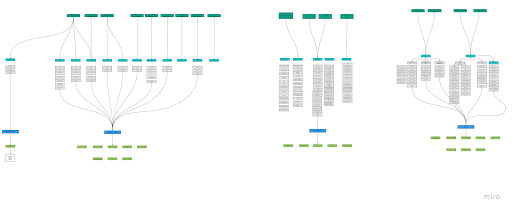
A map of data inputs and siloed systems at Earth Share
A map of data inputs and siloed systems at Earth Share
Our recommendation was relatively simple, consolidate and integrate your existing platforms. This involved cleansing the data in their operational CRM (Andar) to remove any duplicates.
This enables the Andar team to continue using the system as they had previously, but then management could use Salesforce to see and analyse this data.
We suggested migrating their Constant Contact processes over to Salesforce as well. This minimised the tools used and silos between systems. The outcome is an integrated system of martech tools, and sales and marketing alignment.
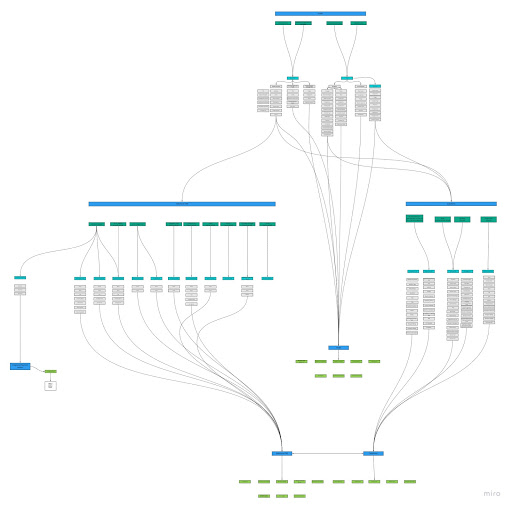
Growth Divison’s recommended map of systems and integrations
Growth Division's recommend map of systems and integrations.
Using innovative methods to generate customers
One of our favourite activities at Growth Division is to test drive new tools for our clients. As growth marketing specialists, a key part of the job is to be creative and come up with ‘growth hacks'.
Martech tools often make this exercise easy for us! Staying ahead of the curve and using new tools can help you generate customers in fun and innovative ways.
Using Your Marketing Tech Stack for Growth Hacking
A good growth hack can accelerate your growth with relatively little costs. This is where you relentlessly focus on a specific growth metric and come up with innovative ideas to ‘move the needle'. You just need to spend some time brainstorming and researching. Can you use martech tools to reach more customers efficiently?
Growth hacking example – using Lempod
Certain tools operate within specific channels to help you acquire customers. For example, a fun new hack we've used recently on LinkedIn is to boost post and stimulate engagement using Lempod.
Join a ‘pod' and request the other members to like or comment on a specific LinkedIn post. This can increase click throughs or act as a lead generator. You can't believe anything on LinkedIn these days!
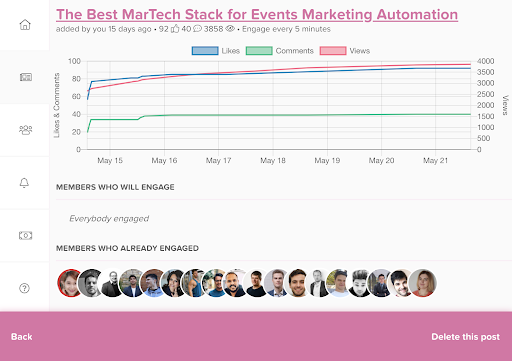
If you want to join the Growth Division pod:
Heyo?
I'm a part of a nice LinkedIn Engagement Pod, the place where you share your LinkedIn posts and get likes/comments from other LinkedIn content makers.
As a result, I can increase my LinkedIn post views by 3x-5x times ?
Hope you will also join it:
- Install lempod here – https://ilya.today/lempod-for-linkedin
- Join a pod with this Secret Code: “3185”
Thanks
Engage with customers more effectively
At the core of any martech stack should be a Customer Relationship Management (CRM) tool. This is the growth engine of your martech stack and should be pulling in data from the other tools. Use this data to build up a profile of each and every customer.
When are they engaging with your business?
When are you communicating with them?
What products have they purchased?
Who is their representative at your company?
These questions are obvious but often can't be answered effectively. A properly implemented CRM will allow you to have a clear understanding of your customers and communicate with them effectively.
We would also recommend building a customer journey map to complement your martech stack and to identify customer touch-points.
Data will set you free.
Data is key to creating personalized campaigns. Set up automation tools that drive workflows that are triggered by certain behaviour as they move through the journey map. Don't forget to get their name right!
To CRM or NOT TO CRM (Hint...you need a CRM).
Which CRM tool to go for is a big decision and will depend on your uses, lead volume, business model, budget and team structure. You can see our CRM recommendations on our Martech Tools page.
Heightened analytics and analysis
Once you're confident the tools are integrated properly and data is flowing seamlessly, it's time to track your stack. Layering on an analytics system over your stack is a vital piece of the puzzle.
This can identify any data silos, any deviations from your intended customer journey and any improvements in your marketing campaigns.
The right time is real-time
The beautiful thing about a martech stack is the real-time information capabilities it can give managers, business owners, and the sales team. Bin your spreadsheets and tell your analyst they no longer have to build your marketing reports – they will jump for joy!
If it can be measured, it can be managed. This applies to your martech stack. There is always a way to pull out real-time information on your operations.
Consolidation and Data visualization
Our preferred tool for this is Databox. Whilst there are loads of analytics tools out there, Databox takes the biscuit for the number and quality of tool integrations. There are more technical solutions out there, like the cool open source automation project Mautic.
However, if you're not particularly technical, a solution like Databox allows you to build queries and dashboards relatively easily. We also love the score card capabilities that allow you to see key metrics in a slack channel – what an age we live in. A sophisticated marketing tech stack demands more than a typical web analytics package like google analytics or you'll be missing out on most of the fun!
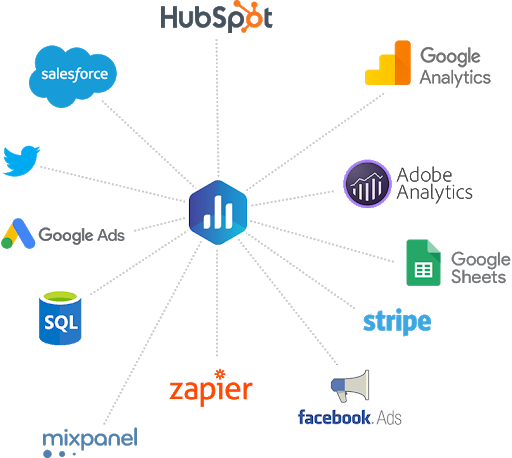
Bring your tools under one roof with Databox
Become agile and adapt your marketing campaigns
With a great martech stack comes great responsibility. Your business will be able to grow rapidly and adapt to changing business conditions and seize new opportunities. Want to test a new channel? Just plug in a new tool for that channel, hook up the data integrations and get testing.
You'll be able to see the impact of new initiatives on generating new customers, and how valuable these customers are to your business. Attracting new, valuable customers is at the heart of any marketing efforts.
We exist in a business world where martech tools are springing up everywhere. Businesses who are archaic in their marketing operations will increasingly fall behind their marketing technology driven competitors.
Just as new technologies are disrupting industries, martech stacks are disrupting the conventional approach to marketing. Build your business one now or risk falling behind.
FAQs
What is marketing automation?
Automated marketing is where software or marketing technology processes are used to automate repetitive activities used in marketing campaigns. The activities typically involved automating email and messaging sequences that were previously sent individually. Migrating data between tools using integrations is another key component of marketing automation. When done correctly in a martech stack, these marketing automations enable businesses to market to more customers in a personalised way within the overall marketing strategy from search engine optimization to paid ads or organic social media marketing.
What is marketing automation software?
Marketing automation software is a segment of marketing technology that refers to the various tools and product companies have created to improve their marketing and sales operations through automation. These pieces of software typically automate various repetitive marketing activities and provide insight and reporting on their respective areas of marketing. A good martech stack is made up of a suite of softwares that all integrate with one another and support or enable the marketing team to execute the marketing strategy.
An example of marketing automation software is Hubspot CRM, you can send a sequence of emails to customers, create blog and social media schedules, and see all the results in their dashboard.
What is the difference between CRM and marketing automation?
Customer Relationship Management (CRM) tools enable businesses to interact with customers in a more personalised way. Typically by consolidating all communications between an organisation and the customers, collection personal data along the way. Automation complements these experiences and enables a CRM to act more effectively. A CRM is at the core of any good martech stack and marketing automation supports the CRM activities. Most CRMs will have marketing automations built in, such as email sequencing which great ease marketing efforts.
What are the best tools for my martech stack?
The tools your use in your martech stack will shape the quality of your marketing operations. Determining what the best tools are will be dependent on the business type, requirements, budget and number of people using them. To be safe, you can go for ‘top of the range' tools like Hubspot, Salesforce, Intercom, but you may be paying an unnecessary price tag. Picking the right tools that fit together into the perfect marketing stack for a specific business is an art and we'd recommend getting in touch with Growth Division if you'd like to discuss this further. A good content management system (CMS) is also a critical tool in the marketing stack. It allows the marketing team to execute the digital marketing strategy without major help from the dev team.
What is a marketing automation specialist?
A marketing automation tools specialist is the engineer in your team responsible for building and maintaining your martech stack. An automation specialist will be the one feeding the marketing stack with new data, running the campaigns and pulling together the reports. They typically have a title along the lines of ‘marketing technologist' or 'marketing technology specialist'. Investing in a specialist who understands marketing automation features can save your organisation tonnes of money and time. Talk to us for more information on this.
Your martech stack
You will now have a better understanding of what is a martech stack. The challenge now is to put one together for your business or to evaluate your current marketing tech stack.
As we've mentioned, there is no one-size-fits-all marketing tech stack. The combination of tools and the marketing automations within them will be unique to you business and your desired customer experience.
Don't be afraid to make changes to the tools you use and be flexible in your approach. Just because you've used a tool for years doesn't mean you have to keep using it.
Especially if it's your CRM. Sometimes the best way forward is to start fresh with a new tool. It will be a pain, but you can migrate your data across to the new tool and tidy it up in the process.
We've created some examples of martech stacks we've used on this site. Feel free to use these for inspiration or get in touch if you'd like to discuss your specific requirements. Remember, a marketing tech stack saves your time and money, so have fun building it!
Talk to a Growth Advisor
We create a clear, focused marketing strategy by combining our expertise with your knowledge of your business.
Trusted by over 130 startups because our unique growth process and team of marketing experts unlock exponential growth




